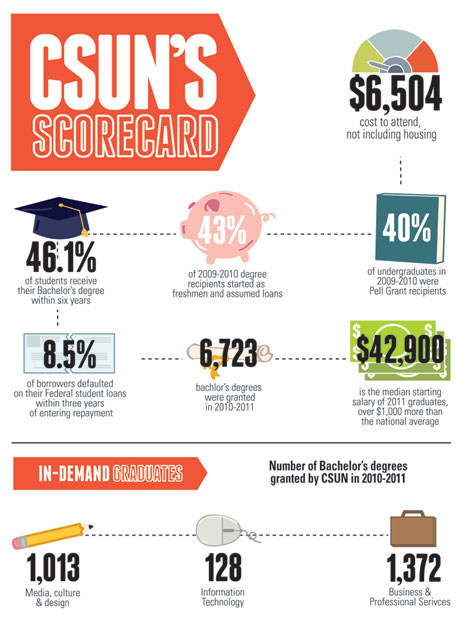
A new online college scorecard aiming to help prospective students and their parents find the right college is now available.
The scorecard, which was announced during President Obama’s State of the Union Address on Feb. 12, provides criteria such as cost, location, size and graduation rates for students to look at when comparing different colleges, according to a fact sheet by the White House press secretary.
Stephanie Thara, web communications specialist for the CSU, said the CSU has generated something similar to the federal scorecard called Measuring the Value of a CSU Education.
“Like the federal scorecard, our site aggregates key information about the CSU and its campuses to help students make an informed decision about what college they would like to attend,” Thara said.
The CSU created the site several years ago because they felt it was important to show prospective students and the public facts about attending the CSU, such as cost, financial aid, diversity and workforce contributions, Thara said.
Dianne Klein, media relations in the University of California Office of the President, said the UC is also aware of the federal scorecard.
“We believe it is a step in the right direction to helping students and their families make informed choices about which college or university suits their needs,” Klein said.
Dr. Shirley Svorny, economics professor at CSUN, said there are already so many private and public sources of information available that she is not sure why the federal government would take on something like this.
“Given the federal government’s budget deficit and the broad array of private companies that rank colleges, I think the scorecard is not a good idea,” Svorny said.
Kara Jew, senior biology major, said she did not know much about the scorecard, but said it seems something like it should already exist because of the details about financial aspects for all universities.
“When I was a senior in high school, I was set on going to a university that was located in California not too far away from home,” she said. “The financial aspects weren’t a major factor in my decision, so the scorecard wouldn’t have been useful for me.”
Ryan Bunyan, freshman mechanical engineering major, said that he thought the scorecard would be very useful for prospective students.
“When I was looking around at colleges, there wasn’t really anything official that would compare campuses so I had to visit the ones I was interested in,” he said. “If this scorecard had been around, I probably would have used it.”
Klein, however, said that not all data relating to the UC system is up-to-date and will need to be fixed.
“As an example, at UC Merced, it lists a six-year graduation rate, but based on the 2009 data they used, UC Merced wasn’t even in existence that long,” Klein said.
Svorny does not expect the scorecard to actually help students in making a decision on where to go to college.
“I expect colleges to fudge the data they report or manipulate it, as colleges do when reporting information for the U.S. News and World Report’s efforts to rank college programs,” she said.
Bunyan said that even though this is a new tool, he would recommend it to other students just starting the college journey.
“I think it’s worth tracking different colleges,” he said. “A lot of kids go to the wrong school because the right resources aren’t available to them. This would allow them to find the right or better option.”
Jew said the scorecard should help a little if a student has no idea where they want to go but does not think it will sway a person’s final decision.
“It would be convenient to have essential cost information about a university in an easy-to-read format, but that doesn’t detail how well the university accommodates a specific major,” she said. “The financial feature is certainly important in the decision making process, but the quality of teaching is, by far, a greater aspect. You can go to a university with a cheaper tuition, but that doesn’t mean you’ll be receiving a quality education.”




